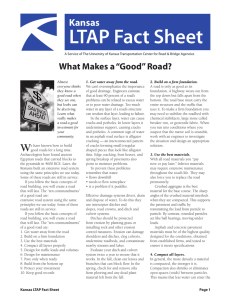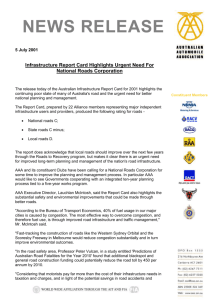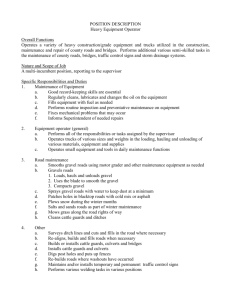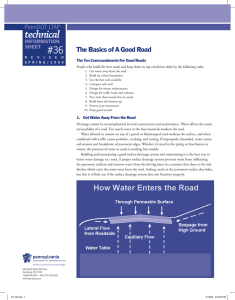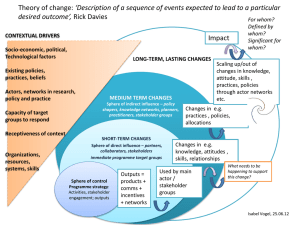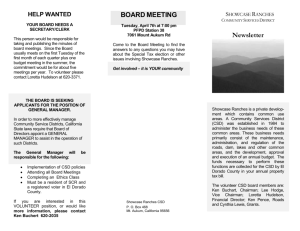Region 7_2012 Minutes 5-30-12
advertisement
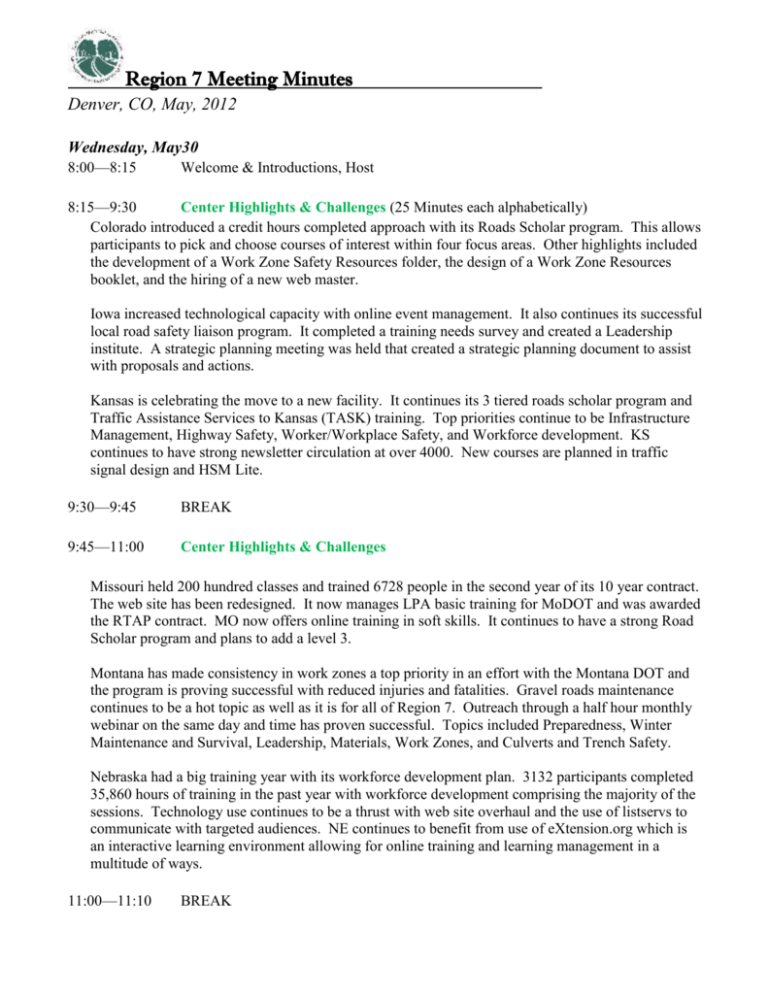
Region 7 Meeting Minutes Denver, CO, May, 2012 Wednesday, May30 8:00—8:15 Welcome & Introductions, Host 8:15—9:30 Center Highlights & Challenges (25 Minutes each alphabetically) Colorado introduced a credit hours completed approach with its Roads Scholar program. This allows participants to pick and choose courses of interest within four focus areas. Other highlights included the development of a Work Zone Safety Resources folder, the design of a Work Zone Resources booklet, and the hiring of a new web master. Iowa increased technological capacity with online event management. It also continues its successful local road safety liaison program. It completed a training needs survey and created a Leadership institute. A strategic planning meeting was held that created a strategic planning document to assist with proposals and actions. Kansas is celebrating the move to a new facility. It continues its 3 tiered roads scholar program and Traffic Assistance Services to Kansas (TASK) training. Top priorities continue to be Infrastructure Management, Highway Safety, Worker/Workplace Safety, and Workforce development. KS continues to have strong newsletter circulation at over 4000. New courses are planned in traffic signal design and HSM Lite. 9:30—9:45 BREAK 9:45—11:00 Center Highlights & Challenges Missouri held 200 hundred classes and trained 6728 people in the second year of its 10 year contract. The web site has been redesigned. It now manages LPA basic training for MoDOT and was awarded the RTAP contract. MO now offers online training in soft skills. It continues to have a strong Road Scholar program and plans to add a level 3. Montana has made consistency in work zones a top priority in an effort with the Montana DOT and the program is proving successful with reduced injuries and fatalities. Gravel roads maintenance continues to be a hot topic as well as it is for all of Region 7. Outreach through a half hour monthly webinar on the same day and time has proven successful. Topics included Preparedness, Winter Maintenance and Survival, Leadership, Materials, Work Zones, and Culverts and Trench Safety. Nebraska had a big training year with its workforce development plan. 3132 participants completed 35,860 hours of training in the past year with workforce development comprising the majority of the sessions. Technology use continues to be a thrust with web site overhaul and the use of listservs to communicate with targeted audiences. NE continues to benefit from use of eXtension.org which is an interactive learning environment allowing for online training and learning management in a multitude of ways. 11:00—11:10 BREAK 11:10—12:00 Center Highlights & Challenges North Dakota sees the retirement of long time director Gary Berreth. We welcome Darcy Rosendahl as the new director. Training achievements in Worker/Work Zone Safety, Highway Safety, Infrastructure Management, and Workforce Development included over one thousand participants. ND highlighted its use of Constant Contact for publications sent electronically, and it continues to be a champion of learning management systems with a strong in-house system that continues to be well received. South Dakota saw an increase of one thousand training participants over last year and record attendance at the regional local roads conference. It has added FEMA training for site inspectors on gravel roads, culverts, and geosynthetic materials. It is closely working with SDDOT on a research project studying life cycle cost of gravel surfacing and continues to deal with customer needs in infrastructure management. 12:00—1:00 GROUP LUNCH 1:00—1:25 Center Highlights & Challenges Wyoming has collected gravel roads traffic data that helped in setting speed limits on unpaved roads. It also participated in data collection for an oil and gas impact study. The rural road safety program has delivered over 2000 signs. A Wind Rivers Reservation Safety Program has been developed to expand access to funding and share crash data with the statewide database. 1:25—3:15 FHWA & Clearinghouse Update, Cameron, Jeff, Susan Jeff and Cameron updated us on PAR. Participants had increased after a 2 year decline. Training sessions and participants are both up over last year. Newsletter circulation and total FTE’s are also down. 60% of training continues to go to locals. NLTAPA/FHWA Joint Safety Program goal: Achieve the fullest possible integration of roadway safety into the program. EDC has had over 2000 participants in the first two EDC exchange events. Strategic Planning committee outcomes: Creation of personalized and/or “themed” PAR data reports, Update/upgrade all PAR/CAR definitions. Synthesize the PAR safety worksheet data for Centers, Advance LTAP/TTAP synergy suggestions into program practice, Expand the LTAP/TTAP brand throughout the FHWA community, Establish a direct network to Divisions, FLH LTAP/TTAP staff, Create a national LPA message. Clearinghouse update: web site redesign in the works. Federal Aid Essentials videos coming soon. Accelerating Safety Activities Program (ASAP): 100k available for the 23 target states. New Technology Transfer Work Group: details to come. 3:30—4:00 NLATAPA EC Update Grapevine 2012, get registered. LoTrans Virtual Conference reminder. New Vice President needed. Vote by June 29 deadline. Workgroup updates. 4:15—4:30 2014 NLTAPA Conference Discussion Omaha, Kansas City, and St. Louis were suggested as possible sites. St Louis was eventually chosen by the executive committee. . 4:30—5:00 MINK and Local Road Coordinators’ Conference Planning Meetings I sat in on the MINK conference planning committee. Most details had been set in advance and we simply confirmed dates and times. Local Roads Coordinators’ Conference:
